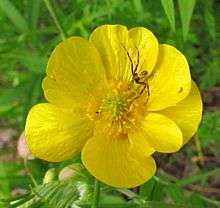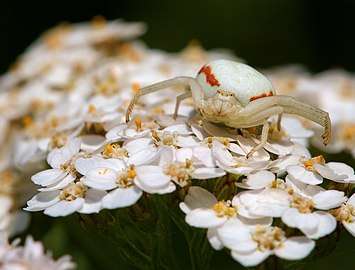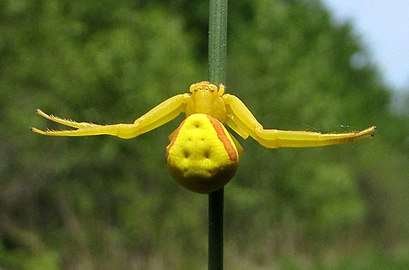Misumena vatia
Misumena vatia is a species of crab spider with holarctic distribution. In North America it is called the goldenrod crab spider or flower (crab) spider,[1] because it is commonly found hunting in goldenrod sprays in the autumn. Young males in the early summer may be quite small and easily overlooked, but females can grow up to 10 mm (0.39 in) (excluding legs); males reach 5 mm (0.20 in) at most.
| Misumena vatia | |
|---|---|
_with_prey_silver-spotted_skipper_(Hesperia_comma).jpg) | |
| Female with prey silver-spotted skipper (Hesperia comma) | |
 | |
| Male is much smaller than female | |
| Scientific classification | |
| Kingdom: | Animalia |
| Phylum: | Arthropoda |
| Subphylum: | Chelicerata |
| Class: | Arachnida |
| Order: | Araneae |
| Infraorder: | Araneomorphae |
| Family: | Thomisidae |
| Genus: | Misumena |
| Species: | M. vatia |
| Binomial name | |
| Misumena vatia (Clerck, 1757) | |
| Synonyms | |
|
List
| |
Description
These spiders may be yellow or white, depending on the flower in which they are hunting (active camouflage). Younger females especially, which may hunt on a variety of flowers such as daisies and sunflowers, may change color at will. However, the color-changing process is not instant and can require up to 25 days to complete.[2] Older females require large amounts of relatively large prey to produce the best possible clutch of eggs. They are therefore, in North America, most commonly found in goldenrod (Solidago sp.), a bright yellow flower which attracts large numbers of insects, particularly in autumn. It is often very hard even for a searching human to recognize one of these spiders on a yellow flower.[2] These spiders are sometimes called 'banana spiders' because of their striking yellow color. They are known to prey on insects such as bumblebees (bombus ternarius)[3] and, in Central America, Trigona fulviventris (a stingless bee).
Reproduction
The much smaller males scamper from flower to flower in search of females, and are often seen missing one or more of their legs. This may be due either to near misses by predators such as birds or to fighting with other males.
When a male finds a female, he climbs over her head, over her opisthosoma and onto her underside, where he inserts his pedipalps to inseminate her.
The female then lays her eggs on plants from the Asclepias genus (milkweeds).[3]
The young reach a size of about 5 mm (0.20 in) by autumn and spend the winter on the ground. They molt for the last time in May of the next year.[2]
Because Misumena vatia employs camouflaging, it is able to focus more energy on growth and reproduction rather than finding food and escaping from predators. As in many Thomisidae species, there is a positive correlation between female weight and egg clutch size, or fecundity.[4] Selection for larger female body size thus increases reproductive success.[5]
Color change
These spiders change color by secreting a liquid yellow pigment into the outer cell layer of the body. On a white base, this pigment is transported into lower layers, so that inner glands, filled with white guanine, become visible. The color similarity between the spider and the flower is well matched with a white flower, in particular the Chaerophyllum temulum (the rough chervil), compared to a yellow flower based on the spectral reflectance functions.[6] If the spider dwells longer on a white plant, the yellow pigment is often excreted. It will then take the spider much longer to change to yellow, because it will have to produce the yellow pigment first. The color change is induced by visual feedback; spiders with painted eyes were found to have lost this ability.
The color change from white to yellow takes between 10 and 25 days; the reverse about six days. The yellow pigments have been identified as kynurenine and 3-hydroxykynurenine.[7]
 Female on Achillea millefolium
Female on Achillea millefolium- Preying on Trigona fulviventris
 Female, imitating a flower
Female, imitating a flower
References
- Acorn, John and Sheldon, Ian. (2003). Bugs of Ontario Edmonton: Lone Pine Publishing.
- "Misumena – Flower Crab Spider". usaspiders.com. Retrieved 12 May 2020.
- Carmen Viera and Marcelo O. Gonzaga (Editors) Behaviour and Ecology of Spiders: Contributions from the Neotropical Region (2017) at Google Books
- Fritz, Robert S., and Douglass H. Morse (1985). "Reproductive success and foraging of the crab spider Misumena vatia." Oecologia 65(2):194–200.
- Head, Graham (1995). "Selection on Fecundity and Variation in the Degree of Sexual Size Dimorphism Among Spider Species (Class Araneae)." Evolution 49(4):776.
- Chittka, Lars (2001). "Camouflage of predatory crab spiders on flowers and the colour perception of bees (Aranida: Thomisidae/Hymenoptera: Apidae)." Entomologia Generalis 25(3):181-187.
- Oxford, G.S. & Gillespie, R.G. (1998). Evolution and Ecology of Spider Coloration. Annual Review of Entomology 43:619-643. doi:10.1146/annurev.ento.43.1.619 PMID 15012400